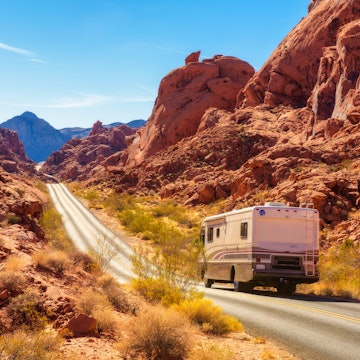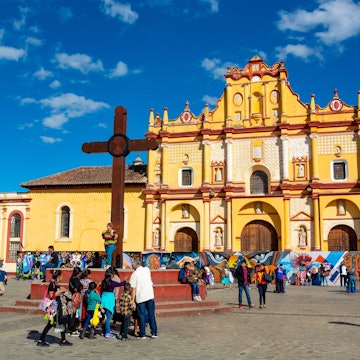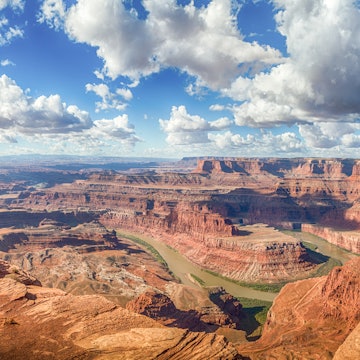
Grand Canyon National Park is geological and human history writ large
Sep 14, 2021 • 6 min read

Formed over millions of years, the Grand Canyon is one of America's most incredible natural sights © Pears2295 / Getty Images
With the launch of Lonely Planet's Ultimate United States Travel List, we wanted to explore some of our favorite American destinations and zoom in a little closer.
Each piece begins with a bird's-eye view of a uniquely American site's history and impact and then zooms in to reveal the lived experience on the ground.
In this article, Southwest native Jay Jones explores the geological and cultural history of Grand Canyon National Park.

35,000 feet: The global view
Peering down into the Grand Canyon in Arizona from an overlook, one begins to comprehend the sheer scale of time present in the multihued bands of rock lining the canyon walls. The first layers were formed about two billion years ago.
Over many millennia, starting in what geologists now call the “basement,” layers of sand, rock and soil expanded upward to create a vast plateau that hid the colorful striations below.
Then, six million years ago, erosion from a series of rivers, including what is now known as the Colorado River, began their downward push, slowly eating through beds of sedimentary rock, splitting the plateau in two and carving a one-mile-deep chasm that, to this day, continues to evolve.

Today, erosion still shapes the canyon, abetted in recent years by climate change. It has not only increased and intensified wildfire season on the rim but caused significantly high and low levels of water in the rivers and streams on the canyon floor. The Colorado River, which flows 277 miles through the Grand Canyon National Park, can be unpredictable. Flash floods can force rapid evacuations of not only hikers and boaters, but also native residents who have lived within the canyon since prehistoric times.
5000 feet: Humans in the frame
A single spear point carved from rock and unearthed by archaeologists is evidence that ancient people hunted in the canyon roughly 12,000 years ago. The deer they may have feasted on are seen in pictographs painted with red ochre. Still visible on canyon walls, the pictographs are as much as 4000 years old.

The first inhabitants of the canyon relied on the river for drinking water, so they built houses and hearths along its banks. Granaries were carved in the canyon’s rock walls. Shards of pottery continue to be discovered; the earliest pots were fired around 1500 BCE. Pottery, wooden stick figures, hunting weapons and other relics are interpreted in various museums within the park.
Eleven native tribes are traditionally associated with the Grand Canyon. “This is [still] their home,” says park spokesperson Joelle Baird. “It’s not a place where they used to live.”

Tribal peoples first saw white Americans in the mid-19th century. Members of an 1856-57 Army-led expedition viewed the Grand Canyon as a “valueless” hole in the ground.
“It looks like the Gates of Hell,” wrote Lt. Joseph Christmas Ives, who led the expedition. “Ours has been the first, and will undoubtedly be the last, party of whites to visit the locality.”
President Theodore Roosevelt turned that notion upside down. In 1908, following several visits to the area, he declared the Grand Canyon a national monument. In 1919, it became a national park. During its centennial in 2019, the park welcomed nearly 6 million visitors, a record.
On the ground: The lived experience
Staring down into the vast canyon, it is understandable why Ives viewed it as intimidating and why Roosevelt was in awe. At a mile deep and up to 18 miles wide, the canyon is a formidable barrier amid the region’s otherwise flat landscape. Only about five percent of park visitors ever descend below the rim into the Inner Canyon, whether for a short hike or an expansive adventure. By foot or astride steady-hoofed mules, intrepid guests can make the 21-mile journey from the South Rim to the North Rim; otherwise, it’s a 137-mile drive.

Ninety percent of tourists see only the South Rim, which is easily accessible from Interstate 40, about one hour away. Some visit for as little as an hour or two. Others experience the grandeur for longer, staying overnight at hotels or campgrounds within the park and in nearby towns.
Visitors inevitably pass through Grand Canyon Village, an actual community with its own grocery store and school system. Its 2500 residents include park employees and their families plus members of the Havasupai Tribe who have opted for the comforts of the South Rim as opposed to in Supai, the tribe’s traditional home amid often harsh conditions deep within the canyon. About 200 native people continue to reside in Supai, home to tribal headquarters and a modest lodge for tourists. Nearby is spectacular Havasu Falls, where the water drops about 100ft into a turquoise-colored pool.
The varying vistas of the North Rim – more remote and about 1000ft higher than the South Rim – are visited by roughly 500,000 people a year, just one-tenth of the park’s total visitation. At an altitude of 8000ft, it has a sub-alpine climate that supports balsam fir, Douglas fir and aspen. The weather here shifts significantly. Summertime can mean big temperature swings, morning fog and, on occasion, dangerous lightning. During the long winters, heavy snow forces the park’s roads and facilities to close between October 15 and May 15.

The National Park Service and the 11 local tribes are working to further interpret ancient and modern cultures. An Intertribal Cultural Heritage Center has been in development since 2013, with the construction of a facility near the East Entrance to the South Rim anticipated to begin in 2022.
“We don’t want to contain it in a building. It really is about a landscape and a people and a voice,” says Jan Balsom, the park’s chief of communications, partnerships and external affairs.
Balsom, who started work at the Grand Canyon in 1984 as an archaeologist, encourages people to use more than simply their eyes when they visit what is one of the Seven Natural Wonders of the World.

“Natural sound is one of the protected resources here at Grand Canyon,” she explains. “Natural quiet isn’t silence; it’s the natural sounds of the place.”
“The Southern Paiute refer to it as a ‘songscape,’” Balsom continues. “It is where their elders would come to learn the songs of their cultures by listening of the sound of the wind through the trees [and] listening to the birds. In certain places in the canyon you can hear the river.”
The buses that shuttle guests to the many scenic spots along the South Rim are no longer allowed to idle at their stops. Parking has also been moved farther away from the overlooks.
“Most people don’t think about it because they’re so caught up in an urban life that they don’t know what natural quiet is,” Balsom adds.
Beyond noise pollution, the trampling of plants and illegal feeding of wildlife are further examples of how millions of annual visitors impact the land.
“There is this balance that we all walk in terms of stewardship, preservation, education and visitor access,” Balsom says. “It’s always an interesting dilemma for us.”
You might also like:
The best of Arizona beyond the Grand Canyon
The best day trips from Sedona
Making waves: the American Southwest’s best river trips















